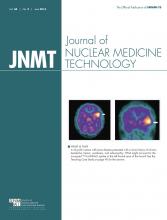Tamara A. Sloper
Revised “IAC Standards and Guidelines for Nuclear/PET Accreditation”
Published in early June, the revised IAC Standards include a few key modifications to the requirements for accreditation. The most significant change is the inclusion of administered dose ranges, which have been added to the IAC Standards in an effort to reduce patient radiation exposure in myocardial perfusion imaging studies, thus ensuring patient safety in accordance with the IAC’s mission of improving health care through accreditation.
Recently published research (1,2) demonstrates that adherence to clinical nuclear imaging guidelines for reduced patient radiation exposure is rarely implemented, resulting in administration of higher doses than necessary for some patients undergoing myocardial perfusion studies. Upon review of this research, the IAC Nuclear/PET board of directors made the decision to include specific administered dose values within the IAC Standards, in an effort to focus facilities’ awareness on the patient dose they are administering. The associated revision to the IAC Standards includes a chart entitled “Current SPECT Myocardial Perfusion Imaging Protocols: Required Radiopharmaceutical Activities and Their Corresponding Radiation Effective Doses” (3), with the ultimate goal of ensuring that the lowest radiation dose is administered to provide optimal imaging results for patients referred for myocardial perfusion imaging studies.
New Quality-Improvement Self-Assessment Tool
To further engage facilities to employ and document continuous quality improvement (QI), the IAC recently released an online tool to assist facilities with newly required QI measures. Through this process, facilities assess their own imaging studies and receive a quantitative report that targets opportunities for improvements, leading to enhanced patient care.
Included as part of IAC’s online accreditation portal, use of the new QI self-assessment tool is offered to participating facilities at no cost. The tool provides participating facilities with a data-driven, objective measure of their QI progress for use in complying with the IAC Standards and fulfilling a variety of quality initiatives. Over time, facilities will be able to benchmark their findings both internally and with the imaging community as a whole.
IAC is excited to make this innovation available to the imaging community and will offer opportunities for attendees at the SNMMI annual meeting to learn more about it. To access a recorded webcast with detailed instructions for use of the new QI self-assessment tool, visit the IAC website (http://www.intersocietal.org/nuclear/main/on_demand.htm) or call us at 800-838-2110.
Research Efforts
As the IAC research program embarks on its fourth year, progress toward fulfilling its mission of strengthening research through accreditation has been realized in terms of several published manuscripts and abstracts. At this year’s SNMMI annual meeting, 3 posters will be presented in conjunction with data collected via the IAC accreditation database from participating facilities: “Poor Adherence to Gastric Emptying Scintigraphy Guidelines: A Report from the Intersocietal Accreditation Database,” “Variability in Gastric Emptying Meals Used in Clinical Practices…Seriously?” and “Gastric Emptying Scintigraphy Protocols: An Educational Guideline to the Rationale for Standardization.” Investigators on each included Lorraine M. Fig, MD, MPH, from the VA Ann Arbor Healthcare System in Ann Arbor, Michigan; Maria Costello, BS, CNMT, NCT, the IAC Nuclear/PET director of accreditation; and Mary Beth Farrell, MS, the IAC director of research.
Accredited facilities, as well as all stakeholders within the medical community, are encouraged to review the research being put forth. A complete listing of published articles, abstracts, and posters can be found on the IAC website (http://www.intersocietal.org/iac/research.htm).
With the purpose of gaining insights into the accreditation process and its value to medicine and society, each year the IAC research committee encourages interested individuals to submit proposals that advance the IAC research committee’s mission of strengthening accreditation through research. Details on how to apply for a research grant are published on the IAC website.
New Leadership
On February 28, 2016, Mary Lally, MS, CAE, became the chief executive officer of the IAC, assuming the role previously held by Sandra Katanick, CAE, the IAC’s founding chief executive officer, who retired after 25 years of service to the organization. Ms. Lally brings a unique combined background of clinical expertise and association management experience. Before her 9-year tenure at the IAC, she was the founding MRI program director at Johns Hopkins Hospital, and she also has experience in developing and implementing radiology quality assurance programs through her role as an assistant radiation safety officer at the University of Maryland Hospital. Ms. Lally is a passionate advocate for quality and safety in imaging.








